Blogging Marvel’s Master of Kung Fu, Part Nine
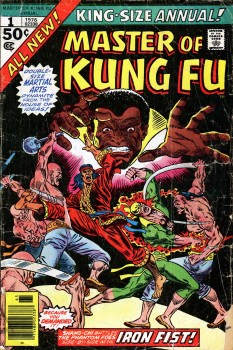 Master of Kung Fu Annual #1 was a reworking of what would have been Giant-Size Master of Kung Fu #5 had Marvel’s short-lived line of quarterly publications not been prematurely discontinued. As it stands it was the only King-Size Annual Marvel published for the series. Marvel Annuals were generally a mixed bag and this is no exception. A few select ones offered truly special longer stories which were a delight for loyal readers, but most were either hurriedly produced or generally disappointing tryouts for aspiring Marvel writers and artists to demonstrate their handling of established properties. Master of Kung Fu Annual fell in the former category with Doug Moench and Keith Pollard tossing off Shang-Chi’s first encounter with Iron Fist.
Master of Kung Fu Annual #1 was a reworking of what would have been Giant-Size Master of Kung Fu #5 had Marvel’s short-lived line of quarterly publications not been prematurely discontinued. As it stands it was the only King-Size Annual Marvel published for the series. Marvel Annuals were generally a mixed bag and this is no exception. A few select ones offered truly special longer stories which were a delight for loyal readers, but most were either hurriedly produced or generally disappointing tryouts for aspiring Marvel writers and artists to demonstrate their handling of established properties. Master of Kung Fu Annual fell in the former category with Doug Moench and Keith Pollard tossing off Shang-Chi’s first encounter with Iron Fist.
The story itself isn’t terrible, but Shang-Chi is almost a guest star in what is essentially an Iron Fist story that is centered on the character’s origins. The visit to the otherworldly dimension that Iron Fist calls home to take on an invasion force led by a sorcerer really seems to be more of a martial arts spin on Doctor Strange. The artwork utilizes some of Steve Ditko’s interdimensional concepts, but without any of his sense of abstract wonder. I was not acquainted with Iron Fist having a mystical background and the story did nothing to make me care much either way as it was clearly knocked off quickly by the overworked Doug Moench. Like the companion magazine, Deadly Hands of Kung Fu, this seemed largely a wasted opportunity. Fans of the character may be interested that there is a brief continuity reference to an ongoing storyline involving Daughters of the Dragon in the companion magazine which one suspects might have made for a more engaging crossover for Shang-Chi, although based on their crossovers in the magazine, perhaps it would have fared no better.
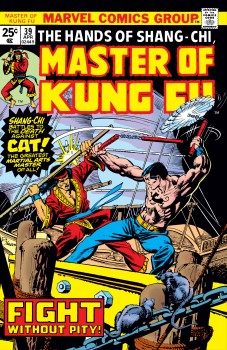
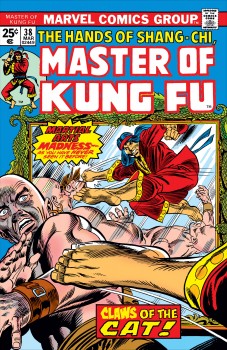 Master of Kung Fu #38 and 39 stand in sharp contrast to the disappointing Annual. It is no exaggeration to state this is the series’ high water mark in quality. Doug Moench and Paul Gulacy achieved a level of artistry and mature storytelling that Marvel had not seen since Steranko’s innovative run on Nick Fury: Agent of S.H.I.E.L.D. in Strange Tales. The two-part storyline sees Shang-Chi dispatched to Hong Kong by Sir Denis Nayland Smith to retrieve stolen government papers from the Chinese and protect MI5’s agent from Shen Kuei, the Cat. The introduction of a Siamese stray cat that Shang-Chi rescues at the story’s impressive opening serves as both a pet to humanize the lead character and as a symbol for both hero and villain as well as the personification of Fate itself.
Master of Kung Fu #38 and 39 stand in sharp contrast to the disappointing Annual. It is no exaggeration to state this is the series’ high water mark in quality. Doug Moench and Paul Gulacy achieved a level of artistry and mature storytelling that Marvel had not seen since Steranko’s innovative run on Nick Fury: Agent of S.H.I.E.L.D. in Strange Tales. The two-part storyline sees Shang-Chi dispatched to Hong Kong by Sir Denis Nayland Smith to retrieve stolen government papers from the Chinese and protect MI5’s agent from Shen Kuei, the Cat. The introduction of a Siamese stray cat that Shang-Chi rescues at the story’s impressive opening serves as both a pet to humanize the lead character and as a symbol for both hero and villain as well as the personification of Fate itself.
The atmosphere of a seedy out of time Hong Kong is quickly established with Gulacy’s art sometimes resembling photographs. The beautiful backgrounds and highly stylized framing of action makes careful use of the white space of the comic page itself as part of the framing and to convey passage of time with isolated panels sometimes representing flashbacks or flash-forwards within the main narrative action. This highly sophisticated form of illustrated storytelling would become the norm for future issues from Moench and Gulacy. The covers above do not do the interiors justice. This run of the series surpasses what Marv Wolfman and Gene Colan consistently achieved with Tomb of Dracula or what Roy Thomas with Barry Windsor-Smith or John Buscema achieved on Conan the Barbarian during the same era. While the issues lack the seminal impact on the genre as Stan Lee’s teaming with Jack Kirby or Steve Ditko in the 1960s, it still stands as the apex of graphic storytelling in the United States.
Moench achieves a connection between Leiko Wu and Shang-Chi’s stray Siamese that rivals the relationship between Audrey Hepburn’s Holly Golightly with her nameless stray in Breakfast at Tiffany’s (1961). Moench’s scripts and Gulacy’s art are heightened by their shared cinematic vocabulary as we quickly see when the MI5 agent in Hong Kong turns out to be sultry nightclub singer, Juliette who strongly resembles Marlene Dietrich. The level of brutality Gulacy was able to convey within the confines of the Comics Code Authority is sometimes almost shocking in its visceral force, particularly in the fight scenes in the night club and casino.
The complexity of sexual relationships, though never explicitly rendered, is nonetheless electrically-charged throughout the story as Moench reveals the nature of Juliette’s abusive relationship with Shen Kuei and contrasts it with Leiko Wu and the heartbroken Clive Reston. Both women are aware of how much their lovers desire them and that drives them to continue unhealthy relationships. Moench (being a true mensch) understands that troubled people are slaves to their appetites and often misjudge lust for love or make the mistake of loving those who can only physically or emotionally wound them. Shang-Chi has not yet plunged into that whirlwind of pain, but he continues to circle it and the reader, like the hero, recognizes the inevitability of his future misstep.
Likewise, Moench continues to depict Shang-Chi’s relationship with Sir Denis in a similar light of unhealthy attachment to another poor father-figure. As much as Shang-Chi protests and makes moral stands, Sir Denis knows the younger man is not yet ready to walk away. A nice twist at the end of the story shows Shang-Chi destroying the secret papers when the enemy agent tells him they were Chinese papers stolen by Juliette rather than the reverse. Only the reader sees the torn papers contained information about Shang-Chi’s father as Moench seeds a larger story to come. The insults Shang-Chi endures in Hong Kong for having become Westernized will also resonate in the future.
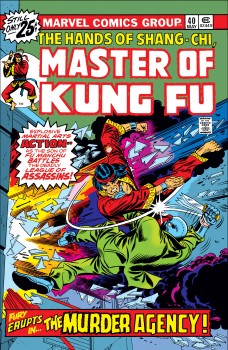 Master of Kung Fu #40 continues the same level of quality with a storyline building on the preceding one. Shang-Chi and his Siamese stray have returned to London. Sir Denis draws him back in with the knowledge that a mole in their organization is leading MI5 agents to assassination. Shang-Chi and Black Jack Tarr are barely in time to save Leiko Wu from Chinese agents who are desperate to learn the identity of an MI5 mole within their agency. The level of violence in their confrontation is simply stunning as the reader imagines something far more graphic than Gulacy actually shows. This is followed by further character development in Shang-Chi’s crumbling resistance to the damaged Leiko Wu and his fraying tolerance for Black Jack Tarr’s casual racism. The issue also sees the introduction of James Larner, disgraced and embittered former MI5 demolitions expert (who is the likeness of Marlon Brando) struggling to overcome his alcoholism to redeem himself after Sir Denis reactivates him to investigate the assassination squad decimating their ranks. Moench also shows how Clive Reston likewise struggles with sobriety in the face of his inability to let go of his relationship with Leiko Wu that continues to hurt him emotionally as much as it satiates him sexually. This is heady, explosive material for a Code-approved title and the reader feels the same jolt by the time the assassination squad hits with grenades and machine guns at the climax. The issue finishes on the revelation that the Chinese agents are operating under the cover of Oriental Expediters, an import/export company in Soho.
Master of Kung Fu #40 continues the same level of quality with a storyline building on the preceding one. Shang-Chi and his Siamese stray have returned to London. Sir Denis draws him back in with the knowledge that a mole in their organization is leading MI5 agents to assassination. Shang-Chi and Black Jack Tarr are barely in time to save Leiko Wu from Chinese agents who are desperate to learn the identity of an MI5 mole within their agency. The level of violence in their confrontation is simply stunning as the reader imagines something far more graphic than Gulacy actually shows. This is followed by further character development in Shang-Chi’s crumbling resistance to the damaged Leiko Wu and his fraying tolerance for Black Jack Tarr’s casual racism. The issue also sees the introduction of James Larner, disgraced and embittered former MI5 demolitions expert (who is the likeness of Marlon Brando) struggling to overcome his alcoholism to redeem himself after Sir Denis reactivates him to investigate the assassination squad decimating their ranks. Moench also shows how Clive Reston likewise struggles with sobriety in the face of his inability to let go of his relationship with Leiko Wu that continues to hurt him emotionally as much as it satiates him sexually. This is heady, explosive material for a Code-approved title and the reader feels the same jolt by the time the assassination squad hits with grenades and machine guns at the climax. The issue finishes on the revelation that the Chinese agents are operating under the cover of Oriental Expediters, an import/export company in Soho.
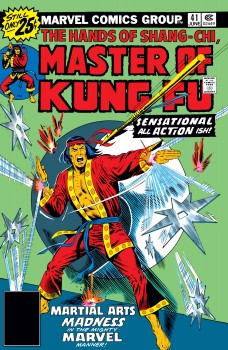 Master of Kung Fu #41 is the almost obligatory filler issue. There was simply no way for Gulacy to keep up the same level of quality of art and consistently meet monthly deadlines for Marvel. Moench makes the most of the opportunity with a stop-gap story that is a flashback to Shang-Chi and his adopted brother M’nai (aka Midnight) in the Honan retreat of their father. The story is overly similar to stories that have appeared previously in the title and highlights just how much the book had improved since then. Sal Buscema’s art was clearly completed in record time. He shows his brother John’s influence as the characters blend with the Buscema renditions of Conan, Hulk, and Tarzan at various times.
Master of Kung Fu #41 is the almost obligatory filler issue. There was simply no way for Gulacy to keep up the same level of quality of art and consistently meet monthly deadlines for Marvel. Moench makes the most of the opportunity with a stop-gap story that is a flashback to Shang-Chi and his adopted brother M’nai (aka Midnight) in the Honan retreat of their father. The story is overly similar to stories that have appeared previously in the title and highlights just how much the book had improved since then. Sal Buscema’s art was clearly completed in record time. He shows his brother John’s influence as the characters blend with the Buscema renditions of Conan, Hulk, and Tarzan at various times.
The next two-parter in the continuing story arc sees the return of Paul Gulacy and he and Doug Moench continue to deliver the goods. Master of Kung Fu #42 and 43 focus on Shockwave, a character that recalls The Shocker from The Amazing Spider-Man, but who is happily rooted in reality. A mentally and physically scarred former MI5 agent, Shockwave has ended up joining the Si-Fan. This is intended as a shock for readers as we realize that not only are the Chinese agents operating under the guise of Oriental Expediters, Ltd. tied to the Si-Fan, but Ducharme is the mole for MI5 feeding information back from the Chinese that Leiko Wu has set out to bring in from the cold. 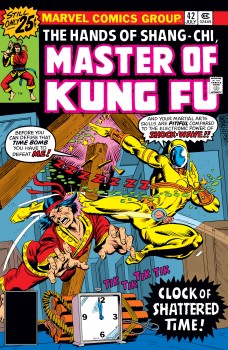
Gulacy becomes even more emboldened with his use of sophisticated storytelling as he takes the subplot of the unknown mole in MI5 planting timebombs and uses clocks to play off the temporal disjointedness of telling the story from alternating points in the narrative. This is actually an expediency of storytelling that allows he and Moench to shoehorn much more story than linear plotting would afford with only two issues.
The introduction of Melissa Greville as Sir Denis’ stunning administrative assistant is a welcome one as the character is the daughter of Shan Greville and Rima Barton from Sax Rohmer’s Daughter of Fu Manchu (1931) and The Mask of Fu Manchu (1932). Sir Denis avoids his intended death by sheer chance as his losing his temper with Shang-Chi just barely draws him out of the blast range when the first of the time bombs is detonated. The revelation that Lancaster Sneed, the former MI5 agent now known as Shockwave is Sir Denis’ nephew is nicely handled.
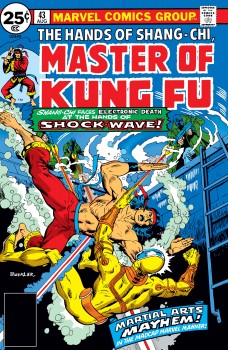 The introduction of the delightfully perverse Sir Herbert Griswold, the Swiss government official who operates an MI5 safehouse is portrayed with the personality and likeness of Charles Laughton. Moench does an excellent job of making the reader find James Larner and Clive Reston increasingly sympathetic as the two friends battle their demons and enemies together. The fate of Black Jack Tarr, the next victim of the timebombs, is left in question.
The introduction of the delightfully perverse Sir Herbert Griswold, the Swiss government official who operates an MI5 safehouse is portrayed with the personality and likeness of Charles Laughton. Moench does an excellent job of making the reader find James Larner and Clive Reston increasingly sympathetic as the two friends battle their demons and enemies together. The fate of Black Jack Tarr, the next victim of the timebombs, is left in question.
The issue concludes with Shang-Chi’s dismay learning of Ducharme’s betrayal of his father. The reader is aware that Dr. Petrie is the mole planting timebombs in MI5 in service of the Chinese, but the principal characters remain in the dark to this startling fact. Moench has successfully moved the espionage model for the series from Ian Fleming to John le Carre with this ongoing story arc. The issue ends with the set-up for the epic eight-part “Return of Fu Manchu” storyline that we will review in our next installment.
William Patrick Maynard is a writer and film historian. His commentaries have appeared on releases from MGM, Shout Factory, and Kino-Lorber. He is the authorized continuation writer for the Sax Rohmer Literary Estate and is the author of new Fu Manchu thrillers for Black Coat Press.
This is where I started reading the series, It frikkin’ BLEW my preteen mind. As you say, Bill, this was one of the best runs of the Bronze Age.
Yeah, agreed, Deuce. It was hard in those days to find issues regularly in my neck of the woods. I know I had three consecutive issues that were bagged together in plastic and sold sealed in a department store. I mainly bought comics at the grocery store. The selection was limited to say the least.
I was a latecomer to MOKF and missed out on all the early Moench/Gulacy issues.
I was delighted to see that Marvel has, at last, found a legal way to reprint the magazine, but haven’t been able to convince myself to buy those expensive hardcover omnibus collections.
I did buy both paperback Epic Collections, though, the second of which takes us through issue #53.
So I’ll shortly be reading the issues celebrated in this eloquent, enthusiastic piece. I gotta say, you really fired me up.
I have to temper my expectations, though. Better than Thomas/Smith/Buscema’s runs on Conan the Barbarian? That’s hard for this old fan to believe.
The Epic Collections are expected to continue at a rate of one each year until all of the material in the Omnibus Editions has been reprinted.
Thank you for the kind words, John. As for my hyperbole, well…my bookshelf contains the following from Marvel: Silver and Bronze Age Hulk, Spider-Man, and Dr. Strange and Bronze Age Conan, Tarzan, Dracula, Frankenstein, and Shang-Chi. Picking who was #1 is likely a question of which I’ve read the most recently and found a run that impressed me.
[…] Books (Black Gate): Master of Kung Fu Annual #1 was a reworking of what would have been Giant-Size Master of Kung Fu […]
[…] Books (Black Gate): Master of Kung Fu Annual #1 was a reworking of what would have been Giant-Size Master of Kung Fu […]
This is very true! Will consider this moving forward 🙂